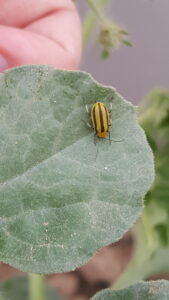This time of year, when we are busy in the fields planting and prepping for a fruitful season, we need to be observant of the pest pressures that may be present. We have already had reports this year of cucumber beetles feeding on recently transplanted cucurbit crops, in particular melons and cucumbers. Let’s review why we despise cucumber beetles so much…
Striped cucumber beetles (Figure 1) are specialists that only feed on crops in the family Cucurbitaceae (cucumber, melon, pumpkin, squash). They overwinter as adults. A proportion of these adults carry a damaging bacteria in their gut, more on this later. As the temperature warms the beetles move out of their overwintering habitat in search of food. They will congregate and feed on young plants. Their feeding causes physical damage to the plant through the loss of leaf material, and for some they transmit a disease. The beetles also mate at this time and lay their eggs at the soil surface. Generally, this emergence is synchronized and can result in a 1-2 week window of high pest pressure. The adults then die off and there is some relief to the crop. The larvae mature in the soil, feeding on plant roots but don’t inflict economic damage. Sometimes they make their way into developing fruits contacting the ground causing damage. In late July-early August is typically when you will see the offspring from these individuals emerge and feeding on the foliage ripening fruit may result in the need for treatment.
The pathogen, Erwinia tracheiphila, which causes bacterial wilt in cucurbits is transmitted by cucumber beetles, primarily striped but also spotted. Check out the video below to see what happens to a plant infected with bacterial wilt. The bacteria need an opening to enter the plant and can do this through a feeding wound. It also needs a moist substrate to live in until it enters the plant. In the case of the insect vectors, this is their frass (aka insect poop). The bacteria reside in the gut of the beetles and when the beetles defecate on the plant, this is the source of inoculum that starts infection. Cantaloupe and cucumbers are susceptible to the bacterial infection; watermelon, pumpkin, and squash generally are not. For the crops that do not suffer from the bacterial disease, we can tolerate a higher number of beetles on the plant. The economic threshold for cantaloupe and cucumber is therefore 1 beetle/plant and increases to 5 beetles/plant for watermelon, pumpkin, and squash.
If you grow cantaloupe in a region with high pest pressures early in the season, it may be beneficial to apply an insecticide to protect young seedlings from feeding and disease. One effective way to manage these beetles, and the disease they transmit, is through the application of a systemic insecticide. A soil or transplant tray drench of imidacloprid (Trade names include: Admire Pro®, Macho®, Midashe Forte®, Montana®) is commonly used. Imidacloprid is one compound from the neonicotinoid group of insecticides. They are water soluble and therefore move quickly into the plant from the soil drench and into the xylem tissues. As soon as the plant ‘takes a drink’ it is carried into the vascular tissues. One study measured lethal amounts of imidacloprid in floral tissues of buckwheat within one day of application killing parasitoid wasps that feed on flowers (Krischik, Landmark and Heimpel 2007, Environmental Entomology). Because of its solubility in water, we can expect older leaf parts and shoots of the plant to be better protected through this application while we find less residues in storage organs, roots and fruits (Sur and Stork 2003, Bulletin of Insectology).
Take heed, though, because some of our own work at Purdue has shown that these chemicals linger in the plant through bloom and are present in concentrations that are deleterious to honey bees. Regardless of application rate (low vs. high label) soil drenches of imidacloprid and thiamethoxam (such as Admire Pro® and Platinum®) can be detrimental to the pollinators that we rely on in these systems. The low rate has been shown to provide sufficient protection against the beetles. If you choose this group of chemicals, apply the low rate. Alternatively, you can make a foliar application of other products such as acetamiprid (Assail®) or a pyrethroid at transplant to protect young seedlings and prevent bacterial wilt while minimizing risks posed to pollinators. These products are not systemic and need to be reapplied to protect new growth if beetles are still present in the crop.
The take-home message? In areas with high beetle pressure, cucumbers and cantaloupe may require pesticide applications to prevent the transmission of bacterial wilt. A systemic compound applied at the low rate is a good choice. Pumpkins and watermelon, which do not become infected with the bacterial wilt, can be protected with a foliar application of a pyrethroid or acetamiprid.
References
Vera A. Krischik, Alyson L. Landmark, George E. Heimpel, Soil-Applied Imidacloprid Is Translocated to Nectar and Kills Nectar-Feeding Anagyrus pseudococci (Girault) (Hymenoptera: Encyrtidae), Environmental Entomology, Volume 36, Issue 5, 1 October 2007, Pages 1238–1245, https://doi.org/10.1603/0046-225X(2007)36[1238:SIITTN]2.0.CO;2
Robin Sur and Andreas Stork, Uptake, translocation and metabolism of imidacloprid in plants, Bulletin of Insectology, Volume 56, Issue 1, January 2003.
